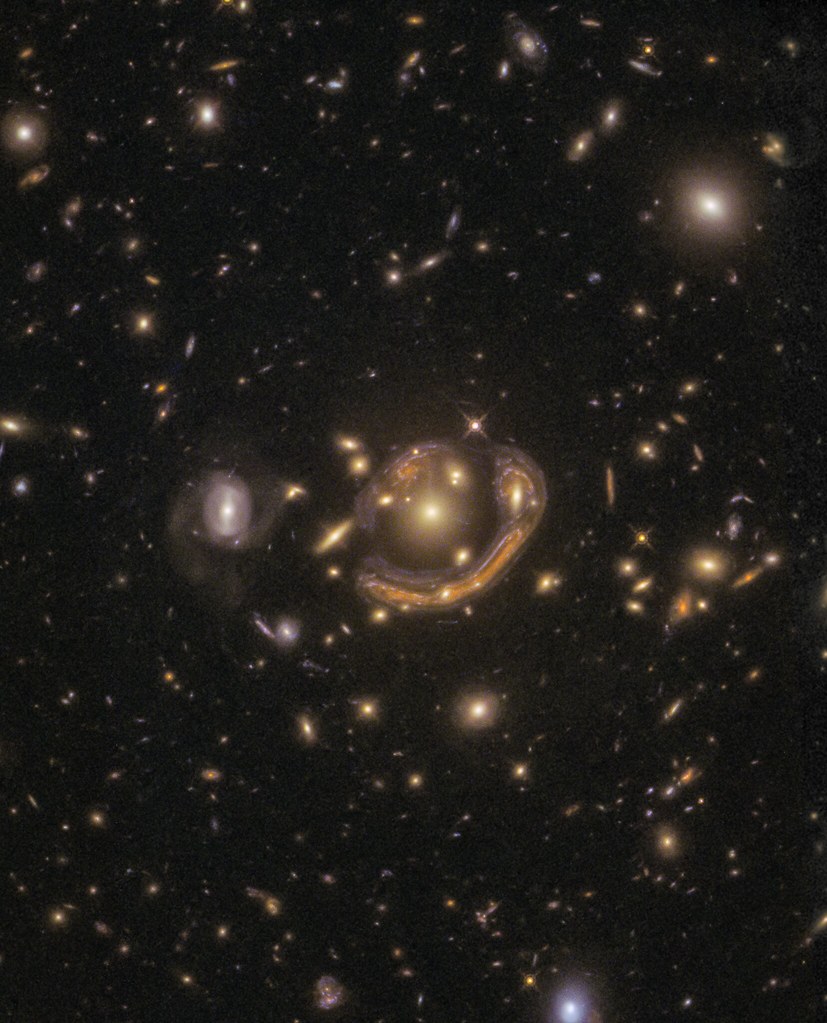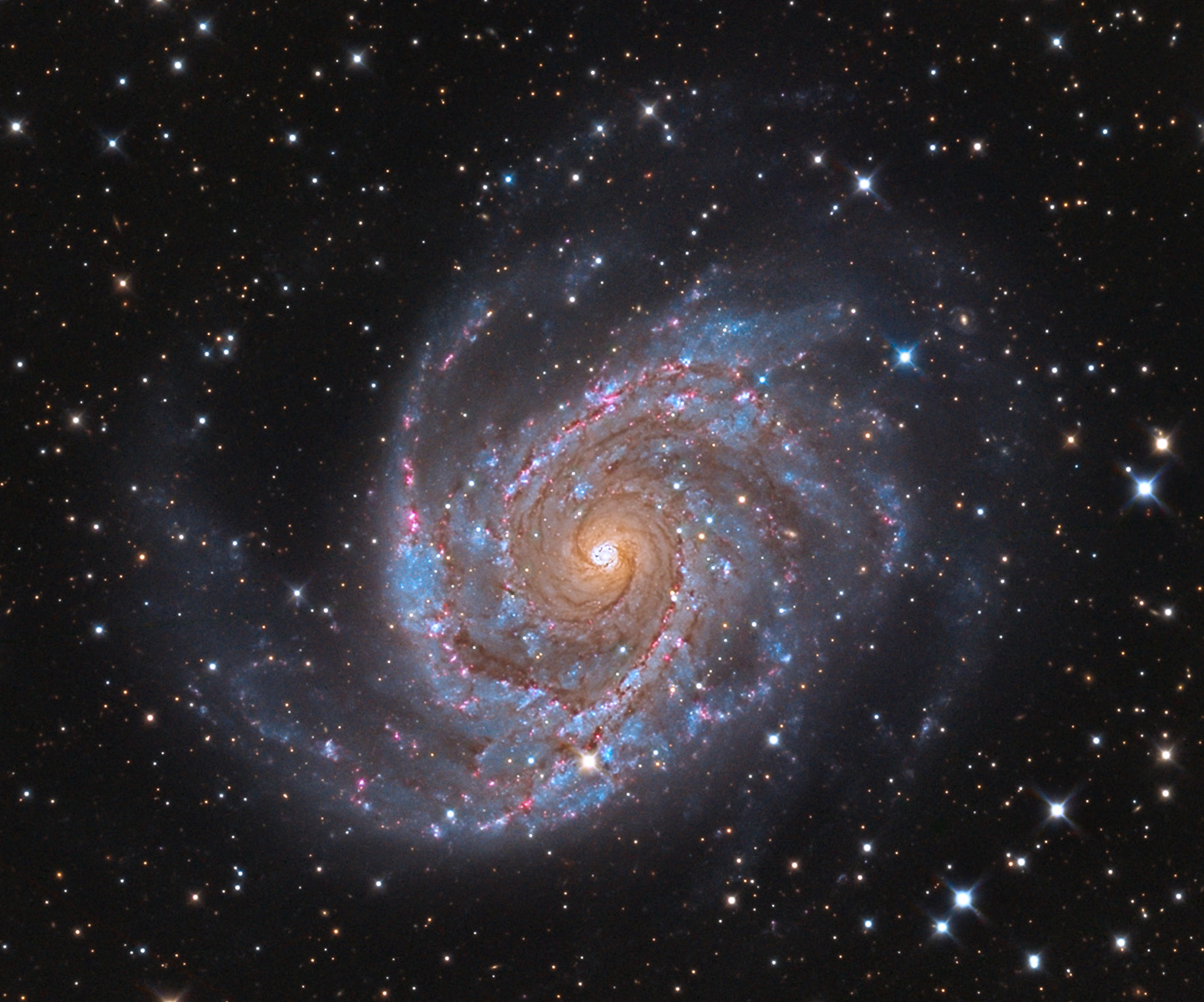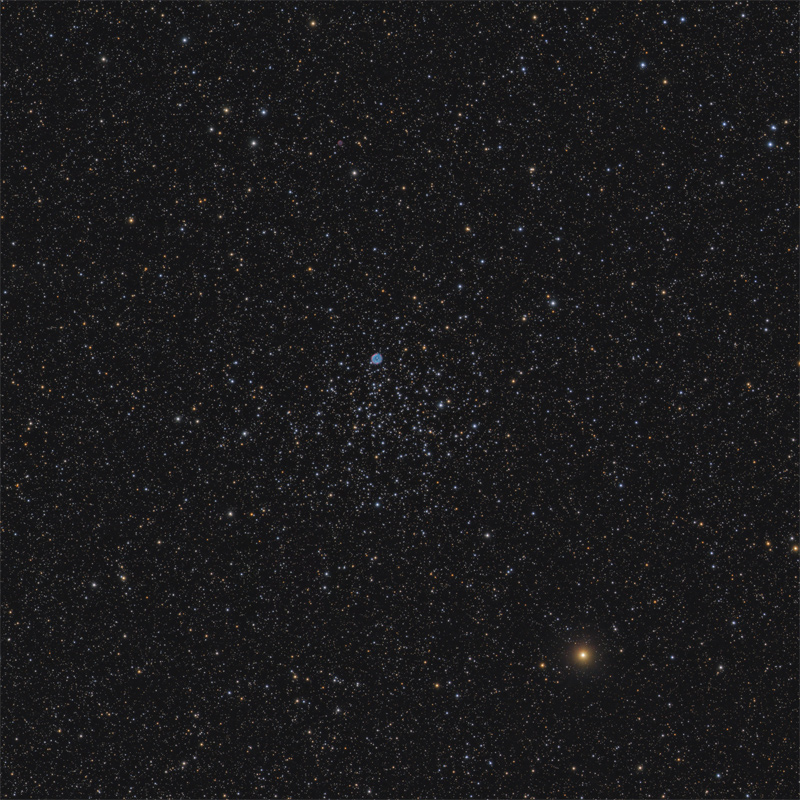Found Images: 2018 June
Re: Found Images: 2018 June
NGC 2997
https://www.adamblockphotos.com/ngc-2997.html
Copyright: Adam Block
I am delighted that Adam Block has uploaded a new galaxy image! NGC 2997 is a splendid-looking spiral galaxy of type SBc. Note the elegant dust lanes winding their way deep into the core of the galaxy, the small bright white ring of of star formation encircling the core, the yellow bulge and the blue and pink starforming spiral arms.
Ann
https://www.adamblockphotos.com/ngc-2997.html
Copyright: Adam Block
I am delighted that Adam Block has uploaded a new galaxy image! NGC 2997 is a splendid-looking spiral galaxy of type SBc. Note the elegant dust lanes winding their way deep into the core of the galaxy, the small bright white ring of of star formation encircling the core, the yellow bulge and the blue and pink starforming spiral arms.
Ann
Color Commentator
-
starsurfer
- Stellar Cartographer
- Posts: 5409
- Joined: Thu Mar 15, 2012 7:25 pm
Re: Found Images: 2018 June
This is the best amateur image I have ever seen of this amazing galaxy! Also credit to David Malin for making this galaxy famous!Ann wrote: ↑Sun Jun 17, 2018 9:12 pm NGC 2997
https://www.adamblockphotos.com/ngc-2997.html
Copyright: Adam Block
I am delighted that Adam Block has uploaded a new galaxy image! NGC 2997 is a splendid-looking spiral galaxy of type SBc. Note the elegant dust lanes winding their way deep into the core of the galaxy, the small bright white ring of of star formation encircling the core, the yellow bulge and the blue and pink starforming spiral arms.
Ann
-
starsurfer
- Stellar Cartographer
- Posts: 5409
- Joined: Thu Mar 15, 2012 7:25 pm
Re: Found Images: 2018 June
Rho Ophiuchi Nebula (IC 4604)
http://www.astrosurf.com/ilizaso/orriak ... Q_U16m.htm
Copyright: Iñaki Lizaso
http://www.astrosurf.com/ilizaso/orriak ... Q_U16m.htm
Copyright: Iñaki Lizaso
ESO: A Planet Hunter and Its Neighbour
A Planet Hunter and Its Neighbour
ESO Picture of the Week | 2018 Jun 18
ESO Picture of the Week | 2018 Jun 18
In this spectacular shot from northern Chile, the immediately recognisable and magnificent constellation of Orion (The Hunter) peers down on the small walkway connecting ESO’s 3.6-metre telescope to the now-decommissioned Coudé Auxiliary Telescope, both located at ESO’s La Silla Observatory.
A closer look at this long exposure, captured by ESO Photo Ambassador Yuri Beletsky, reveals many interesting features — including a streak of light as an artificial satellite passes behind the telescope’s dome (to the right of the frame). Barnard’s Loop, a faint emission nebula thought to be the remnant of a supernova, appears as a faint reddish arc encircling the bright Orion Nebula. Just below and parallel to the walkway, the dark dust lanes of the Milky Way can be seen rippling across the starry sky.
ESO’s 3.6-metre telescope is equipped with the High Accuracy Radial velocity Planet Searcher (HARPS) instrument, one of the most accurate and productive planet hunters in the history of astronomy.
Know the quiet place within your heart and touch the rainbow of possibility; be
alive to the gentle breeze of communication, and please stop being such a jerk. — Garrison Keillor
alive to the gentle breeze of communication, and please stop being such a jerk. — Garrison Keillor
HEIC: One Galaxy, Three Supernovae
One Galaxy, Three Supernovae
ESA Hubble Picture of the Week | 2018 Jun 18
ESA Hubble Picture of the Week | 2018 Jun 18
In astronomy, the devil is in the details — as this image, taken by the NASA/ESA Hubble Space Telescope’s Advanced Camera for Surveys and Wide-Field Camera 3, demonstrates.
The numerous fuzzy blobs and glowing shapes scattered across this image make up a galaxy cluster named RXC J0949.8+1707. Located to the upper right of the frame sits an especially beautiful and interesting barred spiral galaxy, seen face-on. In the past decade, astronomers peering at this galaxy have possibly discovered not one but three examples of a cosmic phenomenon known as a supernova, the magnificently bright explosion of a star nearing the end of its life.
The newest supernova candidate is nicknamed SN Antikythera, and can be seen to the lower right of the host galaxy. This shone brightly in visible and infrared light over a number of years before fading slightly. The two other supernovae, nicknamed SN Eleanor and SN Alexander, were present in data collected in 2011 but are not visible in this image, which was taken a few years later — their temporary nature unambiguously confirmed their status as supernovae. If future observations of RXC J0949.8+1707 show SN Antikythera to have disappeared then we can most likely label it a supernova, as with its two older (and now absent from the images) siblings.
This image was taken as part of an observing programme called RELICS (Reionization Lensing Cluster Survey). RELICS imaged 41 massive galaxy clusters with the aim of finding the brightest distant galaxies for the forthcoming NASA/ESA/CSA James Webb Space Telescope (JWST) to study.
Know the quiet place within your heart and touch the rainbow of possibility; be
alive to the gentle breeze of communication, and please stop being such a jerk. — Garrison Keillor
alive to the gentle breeze of communication, and please stop being such a jerk. — Garrison Keillor
-
starsurfer
- Stellar Cartographer
- Posts: 5409
- Joined: Thu Mar 15, 2012 7:25 pm
-
starsurfer
- Stellar Cartographer
- Posts: 5409
- Joined: Thu Mar 15, 2012 7:25 pm
-
starsurfer
- Stellar Cartographer
- Posts: 5409
- Joined: Thu Mar 15, 2012 7:25 pm
-
starsurfer
- Stellar Cartographer
- Posts: 5409
- Joined: Thu Mar 15, 2012 7:25 pm
Re: Found Images: 2018 June
Cat's Paw Nebula (NGC 6334)
https://www.flickr.com/photos/ak_astro/34877495932/
Copyright: Andrew Klinger
https://www.flickr.com/photos/ak_astro/34877495932/
Copyright: Andrew Klinger
Re: Found Images: 2018 June
NGC 3486
Copyright: Adam Block
http://www.caelumobservatory.com/galler ... nter.shtml
Isn't it a lovely portrait of a wonderfully delicate and beautiful galaxy? Look at that intricately coiled disk of nested blue spiral arms, dotted with rose-colored nebulas, forming what appears to be a near-perfect oval. And there is that tiny little barred yellow bulge in the middle.
Ann
Copyright: Adam Block
http://www.caelumobservatory.com/galler ... nter.shtml
Isn't it a lovely portrait of a wonderfully delicate and beautiful galaxy? Look at that intricately coiled disk of nested blue spiral arms, dotted with rose-colored nebulas, forming what appears to be a near-perfect oval. And there is that tiny little barred yellow bulge in the middle.
Ann
Color Commentator
Re: Found Images: 2018 June
I have to add (since it is too late for me to edit my post) that the unusually blue color of the disk of NGC 3486 is real. James D Wray pointed out, in his eminent The Color Atlas of Galaxies, that the disk and arms of NGC 3486 seems to lack the intermediate population of stars that is so typical of other spiral galaxies. See, for example, this SDSS picture of M51 and NGC 5195, which clearly shows the intermediate to old yellowish stellar populations in the inter-arm regions of M51.
James D Wray said about NGC 3486 that it seems to lack an intermediate population, which suggests that its disk and arms are "all young". That can't be true, of course, but the intermediate stellar component of NGC 3486 is really strikingly weak.
What James D Wray showed in his atlas is that the entire disk of NGC 3486 is quite faint, and that most of the light from this galaxy really comes from its small central region.
Ann
James D Wray said about NGC 3486 that it seems to lack an intermediate population, which suggests that its disk and arms are "all young". That can't be true, of course, but the intermediate stellar component of NGC 3486 is really strikingly weak.
What James D Wray showed in his atlas is that the entire disk of NGC 3486 is quite faint, and that most of the light from this galaxy really comes from its small central region.
Ann
Color Commentator
-
starsurfer
- Stellar Cartographer
- Posts: 5409
- Joined: Thu Mar 15, 2012 7:25 pm
Re: Found Images: 2018 June
NGC 6765
http://www.capella-observatory.com/Imag ... GC6765.htm
Copyright: Stefan Binnewies and Josef Pöpsel
http://www.capella-observatory.com/Imag ... GC6765.htm
Copyright: Stefan Binnewies and Josef Pöpsel
-
starsurfer
- Stellar Cartographer
- Posts: 5409
- Joined: Thu Mar 15, 2012 7:25 pm
-
starsurfer
- Stellar Cartographer
- Posts: 5409
- Joined: Thu Mar 15, 2012 7:25 pm
ESO: New SPHERE View of Vesta
New SPHERE View of Vesta
ESO Picture of the Week | 2018 Jun 25
ESO Picture of the Week | 2018 Jun 25
Sitting between Mars and Jupiter, the doughnut-shaped asteroid belt is packed full of rocky bodies and debris. Despite its fragmented, rubbly nature, the total mass contained within the belt is considerable — roughly four per cent of that of the Moon! The majority of this mass is contained within two distinctive bodies: Ceres, a dwarf planet estimated to make up a third of the mass of the belt, and the asteroid Vesta, which holds around nine per cent of it. Vesta is pictured here.
Vesta was recently observed by the SPHERE/ZIMPOL instrument on ESO’s Very Large Telescope (VLT) — the SPHERE image is shown on the left, produced using the MISTRAL algorithm, with a synthetic view derived from space-based data shown on the right for comparison. SPHERE, the Spectro-Polarimetric High-contrast Exoplanet REsearch instrument, is a powerful planet-finding and direct imaging instrument. ZIMPOL is one of its subsystems: a specialised camera perfectly suited to taking very sharp images of small objects — like Vesta.
The synthetic image was generated using a tool developed for space missions called OASIS. Factors such as the reflectance of Vesta’s surface and the geometric conditions of the VLT/SPHERE observations where accounted for by OASIS, which used a 3D model of Vesta’s shape based on images from NASA’s Dawn spacecraft (which completed a 14-month survey of Vesta between 2011 and 2012).
SPHERE’s image of Vesta is impressive given the separation between Earth and Vesta, and the small size of the asteroid — it lies twice as far from the Sun as our planet does, and has a mean diameter of just 525 kilometres. It shows Vesta’s main features: the giant impact basin at Vesta's south pole, and the mountain at the bottom right. This is the central peak of the Rheasilvia basin, and is roughly 22 kilometres high — over twice as high as the tallest mountain on Earth, Mauna Kea, which rises roughly 10 kilometres from the basin of the Pacific Ocean floor, and nearing the height of the mammoth Martian volcano Olympus Mons.
Know the quiet place within your heart and touch the rainbow of possibility; be
alive to the gentle breeze of communication, and please stop being such a jerk. — Garrison Keillor
alive to the gentle breeze of communication, and please stop being such a jerk. — Garrison Keillor
HEIC: An Aging Beauty (NGC 6139)
An Aging Beauty
ESA Hubble Picture of the Week | 2018 Jun 25
ESA Hubble Picture of the Week | 2018 Jun 25
This rich and dense smattering of stars is a massive globular cluster, a gravitationally-bound collection of stars that orbits the Milky Way. Globular clusters are denser and more spherical than open star clusters like the famous Pleiades. They typically contain hundreds of thousands of stars that are thought to have formed at roughly the same time.
Studies have shown that this globular cluster, named NGC 6139, is home to an aging population of stars. Most globular clusters orbiting the Milky Way are estimated to be over 10 billion years old; as a result they contain some of the oldest stars in our galaxy, formed very early in the galaxy’s history. However, their role in galactic evolution is still a matter of study.
This cluster is seen roughly in the direction of the centre of the Milky Way, in the constellation of Scorpius (The Scorpion). This constellation is a goldmine of fascinating astronomical objects. Hubble has set its sights on Scorpius many times to observe objects such as the butterfly-like Bug Nebula, surprising binary star systems, and other dazzling globular clusters.
Know the quiet place within your heart and touch the rainbow of possibility; be
alive to the gentle breeze of communication, and please stop being such a jerk. — Garrison Keillor
alive to the gentle breeze of communication, and please stop being such a jerk. — Garrison Keillor
-
starsurfer
- Stellar Cartographer
- Posts: 5409
- Joined: Thu Mar 15, 2012 7:25 pm
Re: Found Images: 2018 June
NGC 1316-7
http://www.atacama-photographic-observa ... .php?id=96
Copyright: Thierry Demange, Richard Galli and Thomas Petit
http://www.atacama-photographic-observa ... .php?id=96
Copyright: Thierry Demange, Richard Galli and Thomas Petit
-
starsurfer
- Stellar Cartographer
- Posts: 5409
- Joined: Thu Mar 15, 2012 7:25 pm
-
starsurfer
- Stellar Cartographer
- Posts: 5409
- Joined: Thu Mar 15, 2012 7:25 pm
-
starsurfer
- Stellar Cartographer
- Posts: 5409
- Joined: Thu Mar 15, 2012 7:25 pm
Re: Found Images: 2018 June
-
starsurfer
- Stellar Cartographer
- Posts: 5409
- Joined: Thu Mar 15, 2012 7:25 pm
Re: Found Images: 2018 June
-
barretosmed
- Science Officer
- Posts: 483
- Joined: Thu Oct 12, 2017 6:04 pm
Re: Found Images: 2018 June
SOLAR FILAMENT
They are regions colder than the neighborhood plasma and are held in place by the force of the intense magnetic field.
Because they are cooler than the neighboring regions, the filaments appear in h-alpha images as darker traces. For ease of observation, the recorded scene displays the inverted colors, highlighting the fainter details.
astrobin
https://www.astrobin.com/full/353050/0/...
Equipments:
Apo 150mm triplet
Asi 174mm
Daystar Cromosphere + ERF
Date: June 24, 2018
Sao Paulo-SP-BRAZIL
Copyright: FERNANDO OLIVEIRA DE MENEZES
They are regions colder than the neighborhood plasma and are held in place by the force of the intense magnetic field.
Because they are cooler than the neighboring regions, the filaments appear in h-alpha images as darker traces. For ease of observation, the recorded scene displays the inverted colors, highlighting the fainter details.
astrobin
https://www.astrobin.com/full/353050/0/...
Equipments:
Apo 150mm triplet
Asi 174mm
Daystar Cromosphere + ERF
Date: June 24, 2018
Sao Paulo-SP-BRAZIL
Copyright: FERNANDO OLIVEIRA DE MENEZES
-
Guest
Re: Found Images: 2018 June
Lensed galaxy
copyright:Judy Schmidt NASA/ESA Hubble
https://twitter.com/SpaceGeck/status/10 ... 2194180097
and https://www.flickr.com/photos/geckzilla/28209513487/

Paper in perperation (see tweet)
copyright:Judy Schmidt NASA/ESA Hubble
https://twitter.com/SpaceGeck/status/10 ... 2194180097
and https://www.flickr.com/photos/geckzilla/28209513487/

Paper in perperation (see tweet)
Re: Found Images: 2018 June
Fantastic picture, Geck (and Hubble)!Guest wrote: ↑Fri Jun 29, 2018 6:55 pm Lensed galaxy
copyright:Judy Schmidt NASA/ESA Hubble
https://twitter.com/SpaceGeck/status/10 ... 2194180097
and https://www.flickr.com/photos/geckzilla/28209513487/
Paper in perperation (see tweet)
Ann
Color Commentator







